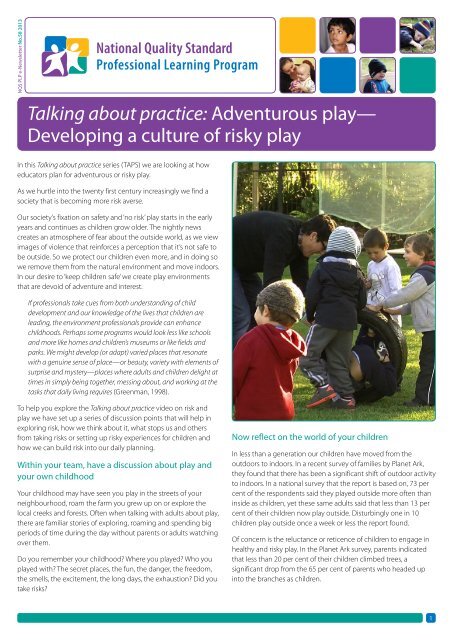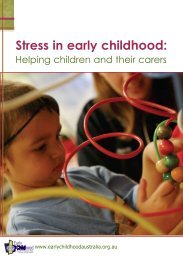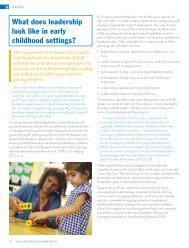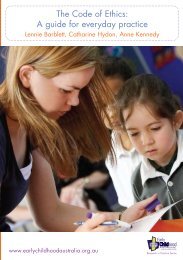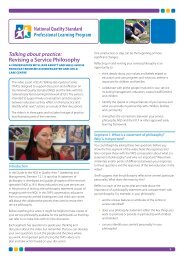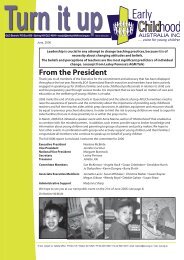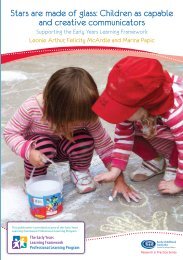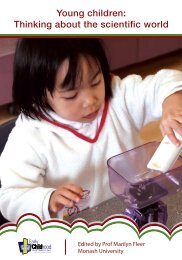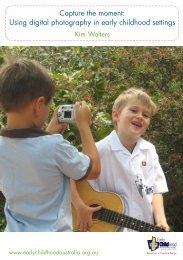Talking about practice: Adventurous play - Early Childhood Australia
Talking about practice: Adventurous play - Early Childhood Australia
Talking about practice: Adventurous play - Early Childhood Australia
You also want an ePaper? Increase the reach of your titles
YUMPU automatically turns print PDFs into web optimized ePapers that Google loves.
NQS PLP e-Newsletter No.58 2013<br />
<strong>Talking</strong> <strong>about</strong> <strong>practice</strong>: <strong>Adventurous</strong> <strong>play</strong>—<br />
Developing a culture of risky <strong>play</strong><br />
In this <strong>Talking</strong> <strong>about</strong> <strong>practice</strong> series (TAPS) we are looking at how<br />
educators plan for adventurous or risky <strong>play</strong>.<br />
As we hurtle into the twenty first century increasingly we find a<br />
society that is becoming more risk averse.<br />
Our society’s fixation on safety and ‘no risk’ <strong>play</strong> starts in the early<br />
years and continues as children grow older. The nightly news<br />
creates an atmosphere of fear <strong>about</strong> the outside world, as we view<br />
images of violence that reinforces a perception that it’s not safe to<br />
be outside. So we protect our children even more, and in doing so<br />
we remove them from the natural environment and move indoors.<br />
In our desire to ‘keep children safe’ we create <strong>play</strong> environments<br />
that are devoid of adventure and interest.<br />
If professionals take cues from both understanding of child<br />
development and our knowledge of the lives that children are<br />
leading, the environment professionals provide can enhance<br />
childhoods. Perhaps some programs would look less like schools<br />
and more like homes and children’s museums or like fields and<br />
parks. We might develop (or adapt) varied places that resonate<br />
with a genuine sense of place—or beauty, variety with elements of<br />
surprise and mystery—places where adults and children delight at<br />
times in simply being together, messing <strong>about</strong>, and working at the<br />
tasks that daily living requires (Greenman, 1998).<br />
To help you explore the <strong>Talking</strong> <strong>about</strong> <strong>practice</strong> video on risk and<br />
<strong>play</strong> we have set up a series of discussion points that will help in<br />
exploring risk, how we think <strong>about</strong> it, what stops us and others<br />
from taking risks or setting up risky experiences for children and<br />
how we can build risk into our daily planning.<br />
Within your team, have a discussion <strong>about</strong> <strong>play</strong> and<br />
your own childhood<br />
Your childhood may have seen you <strong>play</strong> in the streets of your<br />
neighbourhood, roam the farm you grew up on or explore the<br />
local creeks and forests. Often when talking with adults <strong>about</strong> <strong>play</strong>,<br />
there are familiar stories of exploring, roaming and spending big<br />
periods of time during the day without parents or adults watching<br />
over them.<br />
Do you remember your childhood? Where you <strong>play</strong>ed? Who you<br />
<strong>play</strong>ed with? The secret places, the fun, the danger, the freedom,<br />
the smells, the excitement, the long days, the exhaustion? Did you<br />
take risks?<br />
Now reflect on the world of your children<br />
In less than a generation our children have moved from the<br />
outdoors to indoors. In a recent survey of families by Planet Ark,<br />
they found that there has been a significant shift of outdoor activity<br />
to indoors. In a national survey that the report is based on, 73 per<br />
cent of the respondents said they <strong>play</strong>ed outside more often than<br />
inside as children, yet these same adults said that less than 13 per<br />
cent of their children now <strong>play</strong> outside. Disturbingly one in 10<br />
children <strong>play</strong> outside once a week or less the report found.<br />
Of concern is the reluctance or reticence of children to engage in<br />
healthy and risky <strong>play</strong>. In the Planet Ark survey, parents indicated<br />
that less than 20 per cent of their children climbed trees, a<br />
significant drop from the 65 per cent of parents who headed up<br />
into the branches as children.<br />
1
The trend towards risk-free indoor<br />
living: How has the world changed<br />
for children?<br />
The world of children has changed. The family structure has and<br />
is changing, from two parents to one, to blended families and all<br />
combinations in between. We have an increased use of out of<br />
home care services for younger children. With mobility we see<br />
families isolated from extended family units.<br />
There is increasing evidence that the line between home and work<br />
is blurring, especially as we find our reliance on computers and<br />
technology to keep us connected 24/7.<br />
We have witnessed a rise in ‘enrichment’ activities for children—<br />
ballet on Monday, tennis on Tuesday, drama on Wednesday, and<br />
it continues through the week and into weekends. All designed<br />
to give children the edge and to ‘stop them from being bored’.<br />
Increasingly we see governments focus on academic fundamentals<br />
and this increases parental concern over academic achievement.<br />
Have a discussion <strong>about</strong> the world of children today<br />
• What are the differences between your childhood and theirs?<br />
• What influences the decisions we (parents, community and<br />
educators) make <strong>about</strong> children and <strong>play</strong>?<br />
• What opportunities do they have to explore the world?<br />
• Are they able to engage with the natural world?<br />
• Do they have opportunities to take risks?<br />
• Do they have opportunities to run barefoot through grass,<br />
jump in puddles, climb trees or spend time quietly on their<br />
own for the whole day or parts of a day <strong>play</strong>ing in their back<br />
yard, or inside, without adult intervention?<br />
How do we enable children to engage<br />
in risky or adventurous <strong>play</strong>?<br />
To be able to effectively learn, children need to engage in <strong>play</strong><br />
that involves and immerses them, too often risk is taken vicariously<br />
through a screen, that rarely will see the child actually have to<br />
climb a tree, risk a scraped knee or even come into contact with<br />
mud or a splash of water from a cloud burst. Yet we all know these<br />
were invaluable lessons for us as we grew up.<br />
This discussion will explore how early childhood educators provide<br />
opportunity for children to engage in risky <strong>play</strong> and why.<br />
2
Planning for adventurous <strong>play</strong><br />
Being adventurous is <strong>about</strong> creating opportunities for children<br />
(and adults) to explore and test their own capacities, to manage<br />
risk, and to grow as capable, resourceful and resilient children<br />
and adults.<br />
Identifying risk<br />
No <strong>play</strong> space is risk-free. No matter how much we try to remove<br />
the risk of children being hurt, children (and adults) can still<br />
get hurt. We can have the super smooth soft fall surfaces in our<br />
children’s centres and school <strong>play</strong>grounds, but when children walk<br />
out into the real world the surfaces they come into contact with<br />
are anything but that. The greater risk is not providing children with<br />
the skills and abilities to identify and mitigate risk when they come<br />
across it so they can engage with the big wide world.<br />
A risk is something that is possible to negotiate and may be<br />
appropriate for particular situations and children.<br />
A hazard is something that is inherently dangerous and needs<br />
to be remedied, such as a climbing structure with sharp edges or<br />
loose boards that could seriously injure children if they <strong>play</strong> on it.<br />
(Curtis, 2010)<br />
• Think <strong>about</strong> what we mean by risk. What does society say<br />
<strong>about</strong> risk?<br />
• In our children’s <strong>play</strong> spaces do we incorrectly label risk as<br />
a hazard?<br />
We also need to think <strong>about</strong> how we talk to our child when they<br />
are <strong>play</strong>ing. Creating adventurous children is also <strong>about</strong> building<br />
them up through our words and actions, showing joy in their<br />
achievements and also in them just attempting to do something.<br />
Our words can be as simple as ‘you can do it’, ‘how can we make<br />
that happen’, ‘wow you did that so well’, ‘will we try that again’ all<br />
gentle and positive ways of encouraging children to keep going<br />
and not to give up.<br />
Think <strong>about</strong> how you create opportunities for children to take risk.<br />
Think <strong>about</strong> the benefits of risky <strong>play</strong> and how this is supported in<br />
your planning. How do you talk <strong>about</strong> this with children, families<br />
and your colleagues?<br />
How do you reconcile your own knowledge of the benefits of ‘risky<br />
<strong>play</strong>’ with parents’ views? I imagine that many educators watching<br />
the video might say, ‘Well, that’s fine for them, but the parents<br />
at our centre would never let us [insert activity]’. How do you (or<br />
would you) deal with the risk-averse views of some parents?<br />
Adventurers and enquiring minds are nurtured from the early<br />
years, they are encouraged to keep trying, never rescued but<br />
expected to go further, to seek new ways of thinking and doing.<br />
Adventurers are encouraged to be dreamers, to think of what is<br />
possible, to challenge what is known and unknown.<br />
References<br />
Greenman, J. (2005). Caring Spaces, Learning Spaces: Children’s environments that work.<br />
USA: Exchange Press Inc.<br />
Curtis, D. (2010, March-April). What’s the risk of no risk?. Exchange Magazine, 52-56.<br />
• Reflect on the <strong>Early</strong> Years Learning Framework, what does<br />
it say <strong>about</strong> <strong>play</strong>, and risk? What does the National Quality<br />
Framework say?<br />
• Reflect on you and your teams approach to risk assessment<br />
and <strong>play</strong>.<br />
• Think <strong>about</strong> the features of your <strong>play</strong> environments, does<br />
it encourage risky <strong>play</strong>? Are there areas or features that are<br />
problematic? If yes, is this because they are hazards, or that we<br />
think from our own understanding?<br />
Brought to you by<br />
The NQS Professional Learning Program is funded by the<br />
<strong>Australia</strong>n Government Department of Education, Employment and Workplace Relations.<br />
3


